Science
Reusing Recyclables: 10 Science Tools to Make for StudentsMay 22, 2024

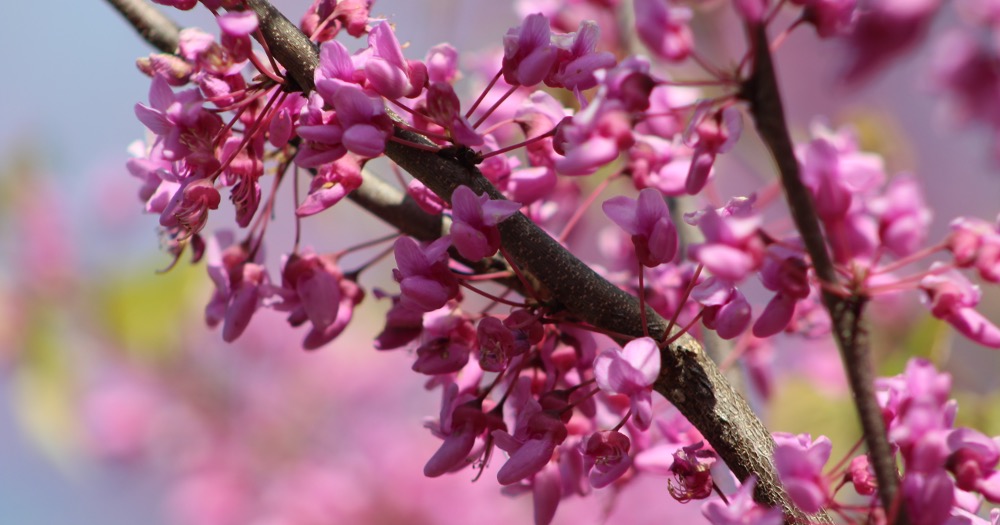
Earth Day is a wonderful opportunity to get your students involved with some awesome stewardship or community service projects. But sometimes brainstorming and planning these sorts of activities is challenging. You’re here to read about Earth Day activities elementary students will love and hopefully you’ll get what you came for!
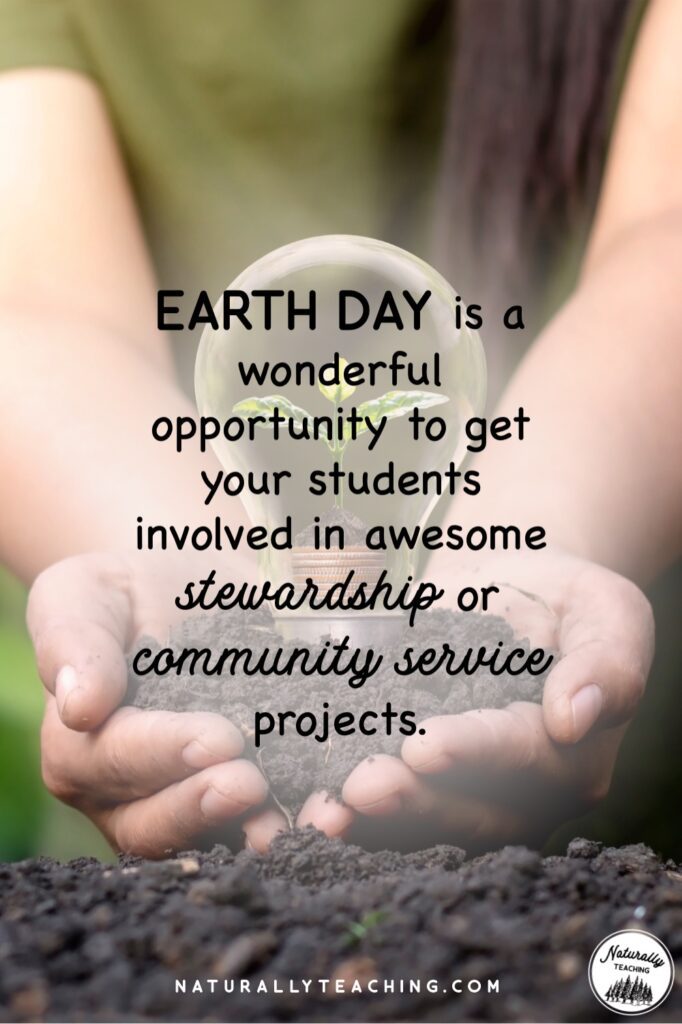
This article will cover some basics about when Earth Day is, its history, the difference between Earth Day and Arbor Day, and ideas for Earth Day activities. If you’re looking for a specific Earth Day topic, consider using this list to jump to the stuff you need:
How to celebrate Earth Day with food
Earth Day is April 22nd every year. The first Earth Day was April 22nd, 1970 and has been observed every April 22nd since with growing numbers of participants.
Before Earth Day, there were many different environmental issues that went unchecked. People were using too much gas. Businesses didn’t need to watch what they released into the air or into the water. Chemicals were killing off songbirds and raptors. Whales were being overharvested and were facing extinction. The list goes on.
The history of Earth Day for students begins with a Senator named Gaylord Nelson. Frustrated with what was happening to the Earth, he scheduled teach-ins across the United States at colleges on April 22nd, 1969. These teach-ins would be used to inform students about the state of the environment and what they could do about it. After its success at colleges, Denis Hayes, an activist assisting Nelson, promoted the event across the country and changed its name to Earth Day.
The first official Earth Day on April 22nd, 1970 saw 20 million Americans inspired. People that had been fighting against pollution, habitat loss, and more, took to the streets in protest. At the end of 1970, these protests brought true change. The United States Environmental Protection Agency was created and environmental laws started to be passed.
In 1990, Earth Day spread to the rest of the world and inspired 200 million people from 141 different countries to protest environmental issues. Since 2010, more than 1 billion people each year participate in Earth Day.
Distinguishing between Earth Day vs Arbor Day can be confusing and challenging at times. Some people celebrate both observance days with acts that help the environment. Earth Day is a day for everyone, worldwide, to work against environmental issues of every kind. This observance day takes place on April 22nd annually.
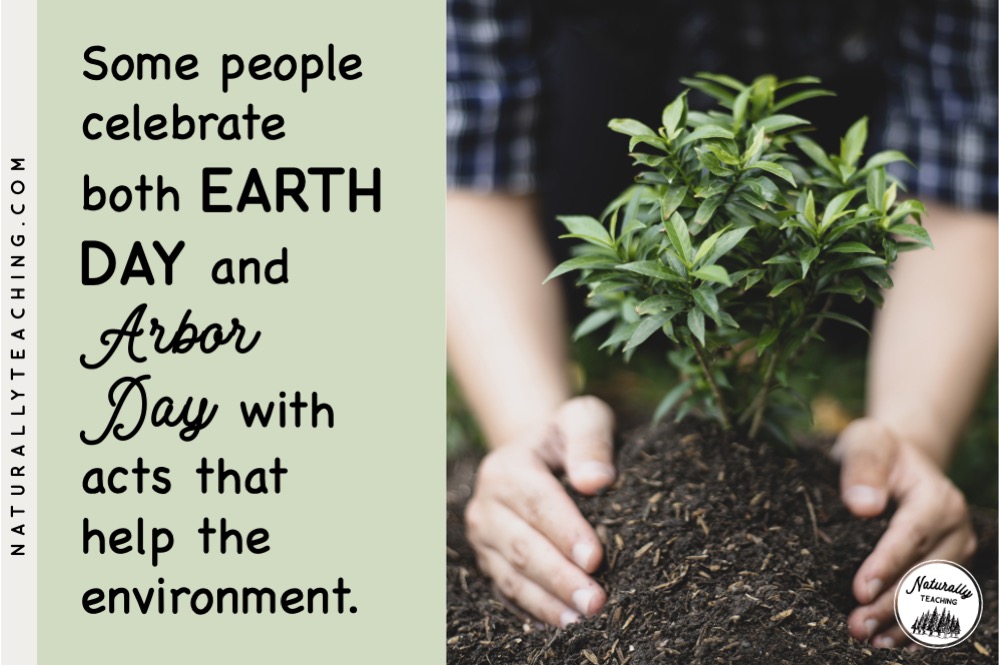
Arbor Day is a day about trees. This observance day can be celebrated on different days depending on the best tree planting season of the region. In the United States, it typically falls on the last Friday of April. This day began as a way to plant trees in Nebraska in the late 1800s when it was covered in plains. Trees helped provide fuel, shade, and also blocked high winds and erosion for the first settlers. The first Arbor Day on April 10th, 1872 saw 1 million trees planted. Although it started as a local holiday, it spread to 45 states by 1920. Nowadays, over 33 countries celebrate Arbor Day globally.
One of the Earth Day activities elementary students will love is reading picture books about Earth Day. Picture books are a great way to introduce new concepts, especially ones that are abstract, such as Earth Day and why we celebrate it. Take a look at some kids Earth Day books to determine which would be best for your classroom introduction.
Our Planet! There’s No Place Like Earth by Stacy McAnulty. This picture book is all about Earth and interesting facts about our unique planet. The author personifies the Earth and gives it a chance to explain all of its awesome features. Some of these features include the ocean, the land, the plants, the animals, and the atmosphere. She also spends time talking about the impact of humans on the Earth and ideas for people to help solve the problems.
Not for Me, Please!: I Choose to Act Green by Maria Godsey. This picture book is about a little boy named Luke who learns what happens with the litter that he makes and how he can make a difference. Through rhyme and rhythm, this story shows what can happen to trash and how it can negatively affect the Earth. He shares obtainable acts that can help the environment including picking up litter, recycling, turning off unused lights, turning off the faucet when not in use, using reusable containers, and more.
Old Enough to Save the Planet by Loll Kirby. This picture book is about real children that helped make environmental changes across the world. Some movements included planting trees, changing from single use water bottles to reusable water bottles, planting mangrove trees to prevent erosion, writing a book to bring awareness and more. Children activists highlighted in this book ranged from ages 7 to 16, making this a very applicable and empowering book for your students.
Butterflies Belong Here by Deborah Hopkinson. This picture book is about a little girl that moved from another country to the United States where she couldn’t speak or read English. She introduces a lot of information about the Monarch butterfly and their migration from Mexico to the northern United States. This lengthy book moves through the seasons and explains the special relationship between Monarch butterflies and the milkweed plants. The main character is empowered by the school librarian to get her class involved in creating a monarch way station; an environmental act accomplishable by a set of students.
There are many more kids Earth Day books, these are just a few to get you started. Some other titles to check out include:
There are many ways to celebrate Earth Day with your class. Earth Day activities for elementary students to celebrate the holiday include a variety of categories.
Many schools implement recycling challenges during the month of April. To make this happen in your school, work together with your students to find a local recycling company that can make a special stop to your school to gather all of the recyclables that your students collect. This could be an ongoing challenge where the students bring recyclables each day of the month where they can earn points for their grade levels for a grade-wide incentive.
Alternatively, it could be a one night experience where families bring in their recyclables and add weight to their respective grade levels for bragging rights. Some recycling centers will even specialize in gathering recyclables that can’t be put in regular recycling bins such as electronics, batteries, and chemicals.
This is another one of the Earth Day activities for elementary students that many schools implement. On a day close to Earth Day, consider using gloves and trash bags to go around your school yard or a local green space and pick up the trash that you find. This will get your school yard looking nice as well as provide more space for plants to grow and animals to find safe food to eat.
Although more involved, a community project or a service project is a great way to help your students feel like they are making a difference. Spend some time in March to do research on a project that your class could complete to help the environment in your community. If you have garden beds at your school that aren’t being used, consider asking your administrator for permission to create a monarch way station or a pollinator pitstop. Many organizations are willing to donate seeds, plants, and soil to environmental causes put together by classes.
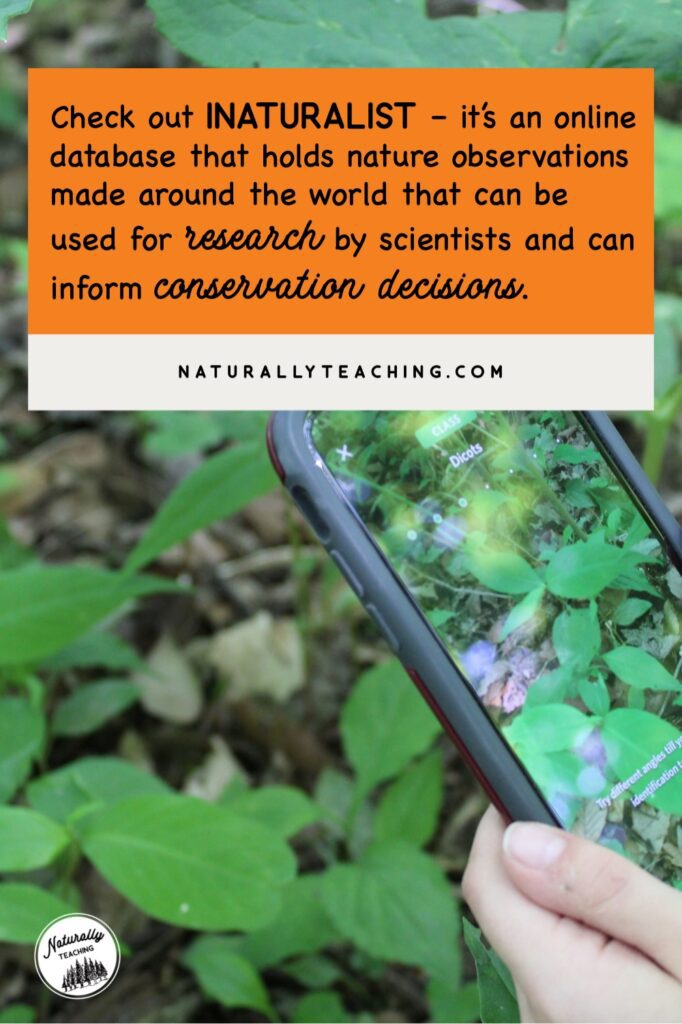
Journey North has a variety of observing and reporting projects that classes can participate in including monarch reporting, hummingbird reporting, American robin reporting, sunlight tracking, leaf-out tracking, and more. These projects often only require you and your students’ eyes and a computer to be able to participate. You can also check out iNaturalist, a free app on your phone as well as a website on your desktop. This project is an online database that holds nature observations made around the world that can be used for research by scientists and can help inform conservation decisions. Again, all it takes is you, your students, and a device to be able to record your sightings.
Not only are community projects and service projects empowering to your students, they often are a part of your social studies and science standards. Yay for working smarter not harder!
Another one of those sure fire Earth Day activities elementary students will love is the incorporation of food! But how to celebrate Earth Day with food? There are a few different categories of ways to use food as a celebration for Earth Day.
Remember, when considering how to celebrate Earth Day with food, it’s important to keep in mind your students’ food allergies as well as the school’s policy on food. In light of the pandemic, more schools have moved toward pre-packaged items in lieu of homemade treats. Check with your administrator if you are unsure of your school’s policy on food sharing.
Celebrate your local farmers and gardeners by sourcing a snack or a meal from the farmer’s market or a local co-op. To get even more local, you could find out if any of your students’ families specialize in growing anything in particular and would be willing to donate to the classroom. To get even closer to school, you could grow herbs or quick-to-fruit plants in your classroom or in a school greenhouse that could be used for your Earth Day snack (this may have to be a project for next year, but keep it in mind!).
This part may be a little tricky since not all organic foods are made equal. There is also the possibly not-so-eco-friendly-part about how the organic food got to your grocery store. The way that a fruit or vegetable can be classified as organic in the United States, is by being grown without the use of synthetic herbicides, pesticides, and fertilizers while also not including GMO’s (aka bioengineered genes).
For meat, eggs, and dairy products to be constituted as organic, the livestock must be raised in a way that mimics their natural behaviors such as being grass fed in a large pasture. These animals also need to be provided organic feed and cannot be given antibiotics, growth hormones, or any animal by-products.
Many times, organic food is grown closer to where it is sold since there aren’t any preservatives to allow for longer travel times and shelf time. However, you should check out the tag and search where the farm is located if you want to know for sure. Organic farming tends to be better for the watersheds in which the farms are located because the farmers don’t use synthetic fertilizers that will run off into the waterways.
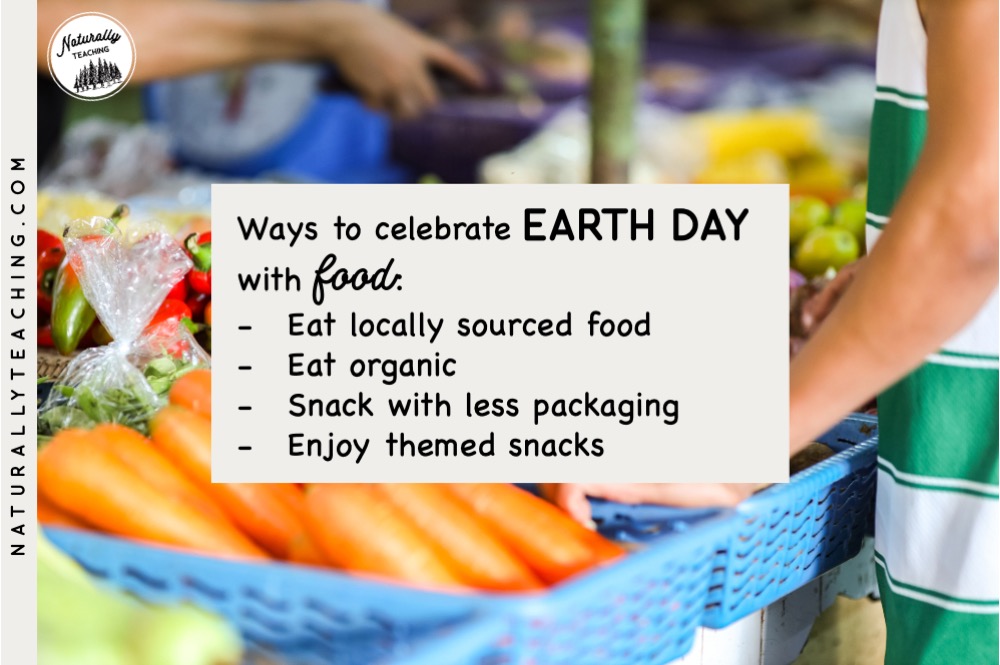
There are some foods that are best to buy organic; these tend to be fruits and vegetables that have the highest pesticide levels, so choosing organic provides less exposure to harsh chemicals. Some of these include apples, cucumbers, celery, potatoes, grapes, strawberries, cherry tomatoes, and peaches. There are some foods that do not have high pesticide levels and are okay to purchase without being organic. Some of these include mushrooms, sweet corn, kiwi, mango, pineapple, sweet peas, sweet potatoes, and grapefruit.
When considering how to celebrate Earth Day with food, make sure to remember your classroom parents. If you choose to give organic foods as a snack or a meal, put together a list and send out a digital invite to your parents to see if they can help donate. Organic food may be better for you, but it’s expensive and it’s hard to commit to buying enough organic food for your entire class.
Empower your students to be more eco-friendly by bringing in snacks that use less packaging. Examples of this could be a snack that came in bulk that they transport in a reusable container. They could pack fruit that they cut up and put in a reusable snack bag. Another option would be to bring in an unpeeled banana – it travels in its own little packaging that won’t get things messy.
If they love transportable applesauce they could pour the applesauce out of a jar and into a small reusable container – this reduces waste by not having the pouches to toss or individual containers to trash or recycle. This form of snacking on Earth Day gives your students the opportunity to participate in a way that is achievable and can help build a lifelong habit.
Who doesn’t love themed snacks? They make eating so much more fun! Instead of taking this burden on yourself, send a link to a signup list for your parents to consider helping out with. If there are particular themed snacks that you want to look a certain way, include the link to the recipe in the signup list or send out recipes to the parents after they have committed.

Check out this list of 10 awesomely themed snacks for any Earth Day celebration!
Earth Day activities can be Googled but not many of the results are tailored to your grade level and curriculum. The Earth Day activities section in this article connects activities and projects to the Headstart Early Learning Outcomes Framework for Preschool and the Next Generation Science Standards for grades Kindergarten through 5th grade.
Looking for Earth Day activities for a particular grade level? Click one of these links to jump to your desired grade:
Preschoolers are a bit young to understand the intention behind Earth Day, but they are more than capable of participating in age-appropriate activities to develop a love of nature and begin the journey to stewardship. Through Earth Day activities for preschool, your students can start to see how interesting the world actually is. Provide your students with engaging and hands-on experiences that will introduce them to the wonder of the nature around them.
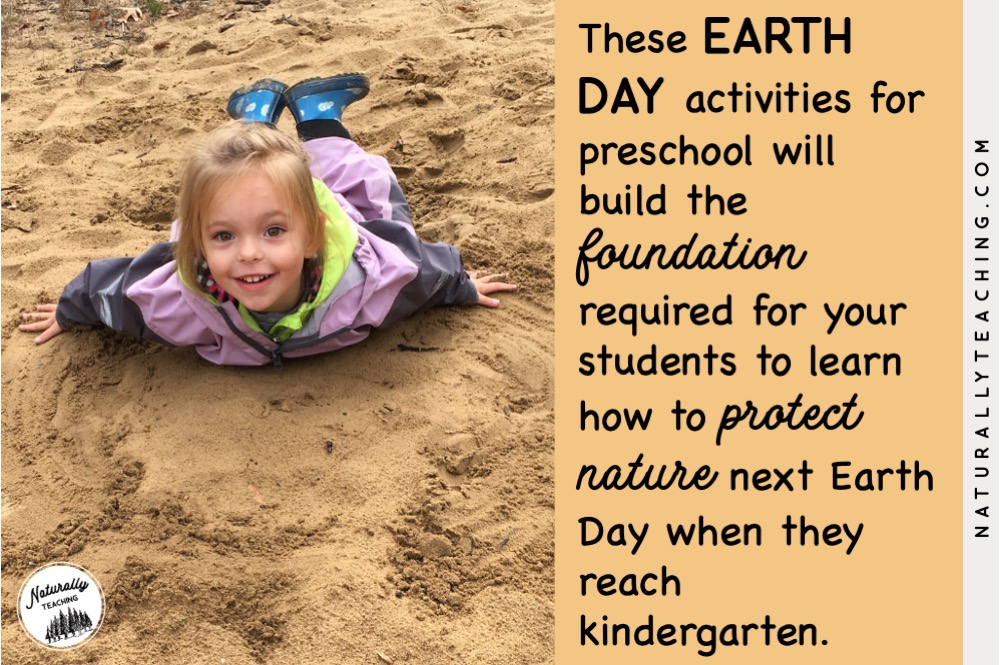
By using Earth Day activities for preschool, you are working toward the Headstart Early Learning Outcomes Framework goal P-ATL 11: child shows interest in and curiosity about the world around them. Introduce exploring nature to your students through a picture book such as Thinking of Nature by Amy Mucci or I Hear You Forest by Kallie George. These books encourage your students to be in the present moment with nature, helping to develop a love of the plants and animals around them.
After getting your students oriented to exploring and being present in nature, take them outside and give them the chance to observe and investigate the nature near your school. Building a love of nature is the first step to protecting nature. Give your preschoolers time to find insects, smell flowers, climb on stumps, and roll logs. These Earth Day activities for preschool and the fresh air will build the foundation required for your students to learn how to protect nature next Earth Day when they reach kindergarten.
Kindergarteners are on the young side to really understand what Earth Day was created for and the impact that people who take action on this day can have. However, through Earth Day activities for kindergarten, they can start to feel how their actions can make a difference to the nature they have around them.
By using Earth Day activities for kindergarten, you are working toward the Next Generation Science Standard (NGSS) K-ESS3-3: communicate solutions that will reduce the impact of humans on the land, water, air, and/or other living things in the local environment. As always, books are a great way to introduce an eco-centered scenario or concept to early childhood readers. Read aloud a book like The Day the Trash Came Out to Play by David M. Beadle or The Mess That We Made by Michelle Lord.
A simple way to get your kindergarteners fired up is to provide them with a scenario that they can make a visible difference with. A trash pick up in your school yard is one way they can see the difference that they are making. Another option would be to keep track of the amount of trash they throw away during Earth Day week – can they get the amount to decrease each day by making different decisions? An additional option would be to weed around plants in the school’s garden or flower beds to help the plants fulfill their needs.
1st graders are ready for more complex scenarios than kindergarteners, but are still learning how their actions can make a difference. Through Earth Day activities for 1st graders, you can empower your early childhood learners to find out how their actions can positively affect their community. Turn your students’ attention to a human-made problem they have noticed and see if they can get inspired by plants and animals to find a solution to the problem.
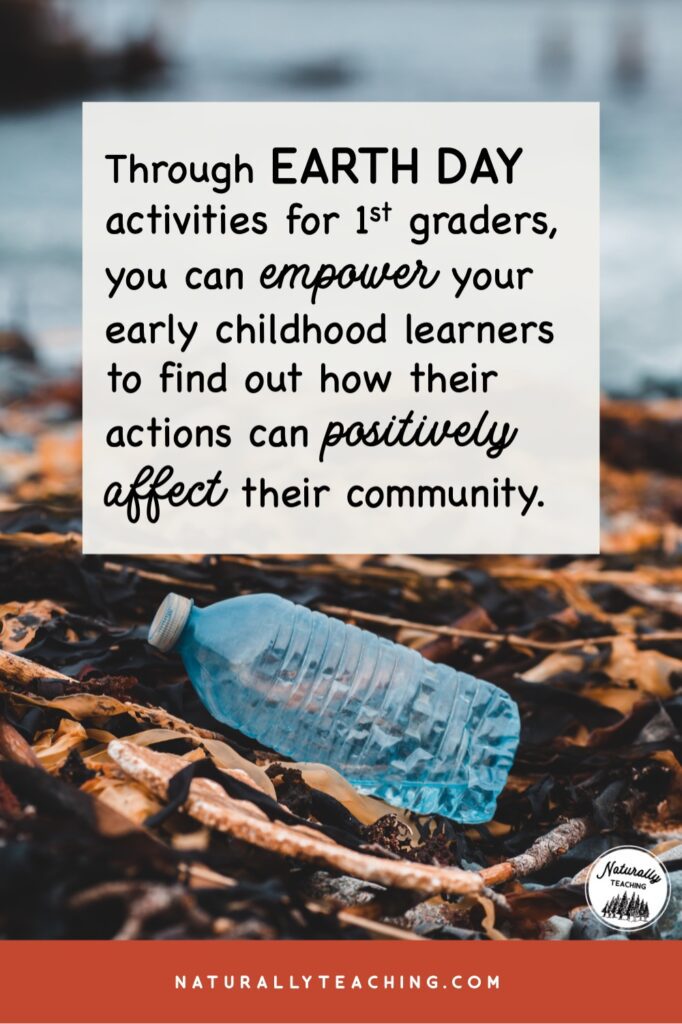
By using Earth Day activities for 1st graders, you are working toward the Next Generation Science Standard (NGSS) 1-LS1-1: use materials to design a solution to a human problem by mimicking how plants and/or animals use their external parts to help them survive, grow, and meet their needs. Begin by brainstorming some human-made problems that affect the environment. If they get stuck, some ideas could include:
Try to help steer your little engineers to a problem that they could conceivably create a solution for that would be inspired by local plants and animals.
Introduce the concept of biomimicry to your students by reading a book such as Going Places by Paul A. Reynolds or Nature Did It First by Karen Ansberry. After getting them inspired, remind them of the problem they identified and give them a chance to start researching plants and animals to see if they can design a solution. This activity will work best for 1st graders if they have support from classmates, so consider putting your students in pairs or small groups.
Give them library books or access to the internet and let them spend time researching and designing a solution. If you want to give them a chance to build a model, consider providing them with a variety of craft materials, clean recyclables, and materials from nature to build a prototype to their solution. You can ask parents to donate *clean* recyclables and craft materials to your classroom for these sorts of builds. Give them an opportunity to share their solutions with the rest of the class on Earth Day as a celebration of their hard work.
2nd graders are maturing from their 1st grade mentality and can benefit from more extensive projects. Through 2nd grade Earth Day activities, you can help your students understand where water is located near you and how they can help keep it safe. Use Earth Day week as an opportunity to introduce the concept of a watershed and which watershed they are a part of. A child-friendly definition of a watershed is an area of land where all the water drains to the same place.
By using 2nd grade Earth Day activities, you are working toward the Next Generation Science Standard (NGSS) 2-ESS2-3: obtain information to identify where water is found on Earth and that it can be solid or liquid. By becoming familiar with where water is found on Earth, your students can see how interconnected the waterways really are and how one act from upstream can affect the water used by many organisms downstream.
Consider giving your students a chance to create a physical or 2-D model of your local watershed. You can usually find a watershed map that you can project onto a screen to help your students see the land and waterways that make up your watershed. By providing your students with a local lens, this will help your 2nd graders understand that this isn’t a problem happening far away, water problems affect regions and organisms everywhere.
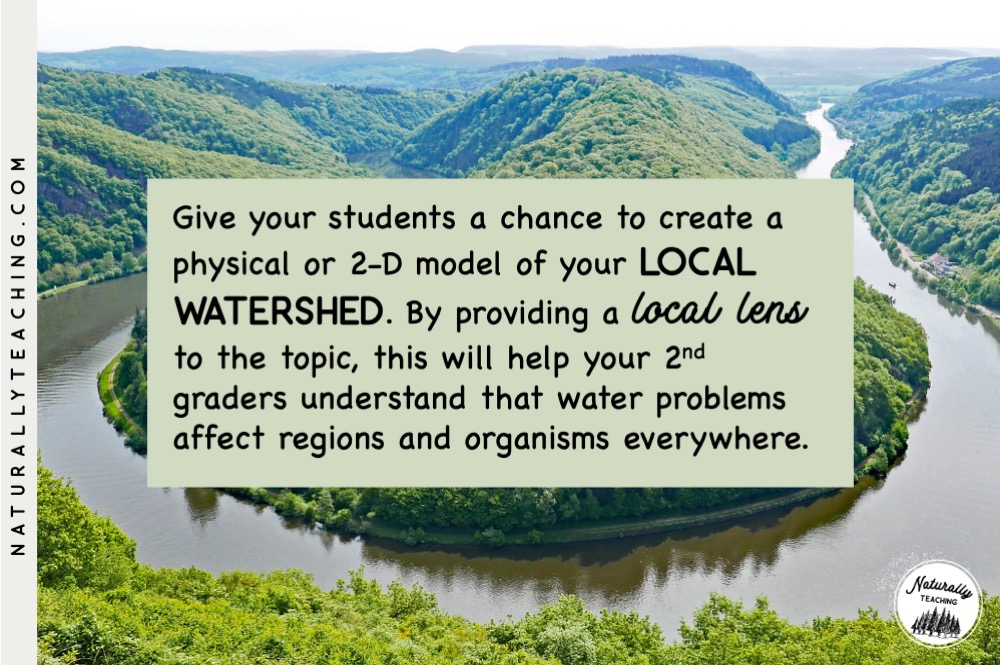
After mapping your watershed, give your students the opportunity to find out how their water is cleaned for use at their school. There should be information on your city’s website as to which water company supplies the water to your school. Provide your students with the name of the company and have them research how they purify the water they use on a daily basis. This can give them background information on one method used to clean water for use by people.
After they have learned about how their water is cleaned and provided to them, give them a chance to be engineers. Their goal could be to try to invent a new way to clean polluted water. This will likely result in all sorts of different ideas, but it will get them thinking about the water cycle and ways they can be helpful to their community.
If you want to give them a chance to build a model, consider providing them with a variety of craft materials, clean recyclables, and materials from nature to build a prototype to their solution. You can ask parents to donate *clean* recyclables and craft materials to your classroom for these sorts of builds. Give them an opportunity to share their solutions with the rest of the class on Earth Day as a celebration of their hard work.
Excited about this idea but don’t have the time to put it all together? Check out my Earth Day Engineers Water Mini Unit for 2nd Grade for premade worksheets and 5 days worth of activities.
Earth Day for 3rd graders can include activities that harness the critical thinking skills and experiences that come with upper elementary students. Through intentional experiences, you can help your students understand what wetland mitigation is and how it can be used to provide a disappearing habitat that is needed by many animals.
By providing activities on Earth Day for 3rd graders, you are working toward the Next Generation Science Standard (NGSS) 3-LS4-3: construct an argument with evidence that in a particular habitat some organisms can survive well, some survive less well, and some cannot survive at all. Wetland mitigation is a wonderful vehicle to teach this concept because it is a human solution to a human-made problem to better the environment and provide renewed habitat to plants and animals. A child-friendly definition of wetland mitigation is the replacing of wetlands when there is human activity that destroys them.
Provide your students the opportunity to research different kinds of wetlands and the things that make them unique. Wetlands are special thanks to three characteristics:
Some examples of wetlands that your students can research include rivers, lakes, marshes, bogs, swamps, and fens. Thanks to Section 404 of the Clean Water Act, each of these unique ecosystems would require replacement if they were destroyed by humans.
Have your students map your local watershed. By looking up and mapping the watershed, they can identify where wetlands are in your region and how they interconnect. Pose a scenario to your students about one of your local wetlands being destroyed in order to put up a strip mall or other business. Where do they think they should add a new wetland to give reprieve for the plants and animals that would be homeless?
Have them add their new wetland to their watershed map and explain why they think this spot would make a good addition to the watershed. On Earth Day, give your students a chance to share their maps with the rest of the class in celebration of their hard work.
Excited about this idea but don’t have the time to put it together? Check out my Earth Day Engineers Habitat Mini Unit for 3rd Grade for premade worksheets and 5 days worth of activities.
Earth Day projects for 4th graders can include a variety of activities. By being intentional with your selection of Earth Day projects for 4th graders, you can introduce and develop your students’ understanding of weathering and erosion. This somewhat abstract concept can be learned best through hands-on experiences and Earth Day week can give you the inspiration and the excitement needed to jump all in to different projects.
By providing Earth Day projects for 4th graders, you are working toward the Next Generation Science Standard (NGSS) 4-ESS2-1: make observations and/or measurements to provide evidence of the effects of weathering or the rate of erosion by water, ice, wind, or vegetation. If you have not introduced weathering and erosion yet, consider doing so with a picture book such as Cracking Up: A Story About Erosion by Jacqui Bailey or Erosion: Changing Earth’s Surface by Robin Koontz. Weathering and erosion can be confusing topics so using a picture book and real examples can help your students begin to differentiate the two.
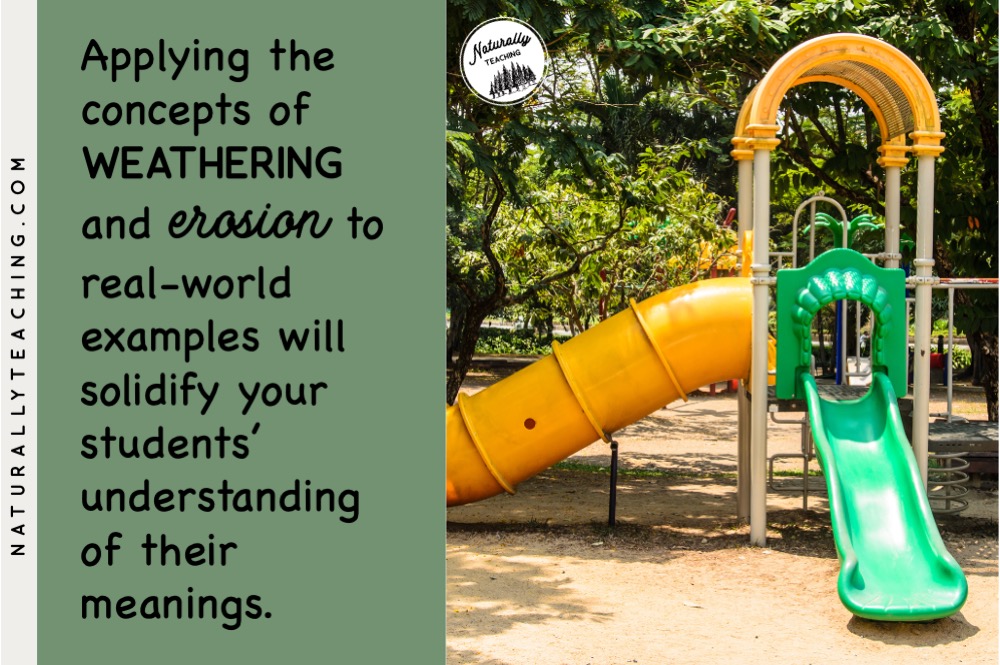
After introducing weathering and erosion, applying these two words to real-world examples will help solidify your students’ understanding of their meanings. Take a look at your school lot to see if you can find any examples that hit super close to home. Some examples could be:
If you cannot find signs of weathering or erosion in your school lot, consider taking a brief walk down the sidewalk near your school to see if you can find any.
After identifying examples of weathering and erosion close to your school, have your students go to work engineering responsible solutions for these issues. Have them work together with a partner to figure out different ways they could keep the sand around the play equipment that would also keep the kids safe. They could figure out what could redirect the rain runoff so it didn’t move the flowerbed soil or a way that could keep the soil from being dislodged by the runoff. Finding a solution to potholes could be an interesting task, especially in a responsible, eco-friendly way. Have them research their ideas and then present their solutions on Earth Day as a celebration for all of their hard work.
Earth Day for 5th graders can include activities inspired by citizen science. Through intentional experiences, you can help your students understand how communities use science ideas to protect the Earth’s resources and environment. This sort of teaching will empower your students to see that their behaviors and choices have positive impacts on their community as well as create concrete memories that will help them have a deeper understanding of the curriculum.
By providing activities on Earth Day for 5th graders, you are working toward the Next Generation Science Standard (NGSS) 5-ESS3-1: obtain and combine information about ways individual communities use science ideas to protect the Earth’s resources and environment. A huge concern recently is the decline of pollinators, most particularly bees.
Consider taking part in The Great Sunflower Project, an online survey of pollinators that spans the entire year. This easy-to-join project requires you to watch a plant somewhere for 5 minutes and count the number of visits pollinators make to the plant. Then, you hop onto their website and add the count to their database. Easy as that!
You may be concerned about identifying the plants and the pollinators that visit them. The wonderful thing about this project is that their website provides lots of resources for teachers and participants. Some of these resources include pollinator info, downloadable data sheets, bee natural history cards, bee identification cards, teacher-specific resources, and more.
In addition, you could also download the free app “Seek” that connects to the iNaturalist database to help you identify plants and animals based on local data that has already been collected. This sort of project will help your students see how they can assist scientists in their data collection and how that data can be used to inform conservation efforts which will in turn help their community.
For more information on this citizen science project, check out their website at https://www.greatsunflower.org/. For another citizen science project you can participate in with your students in February each year, check out my article “The Great Backyard Bird Count: How To Take Part for Elementary Teachers.”
When considering Earth Day activities elementary students will love, crafts are always a huge hit!
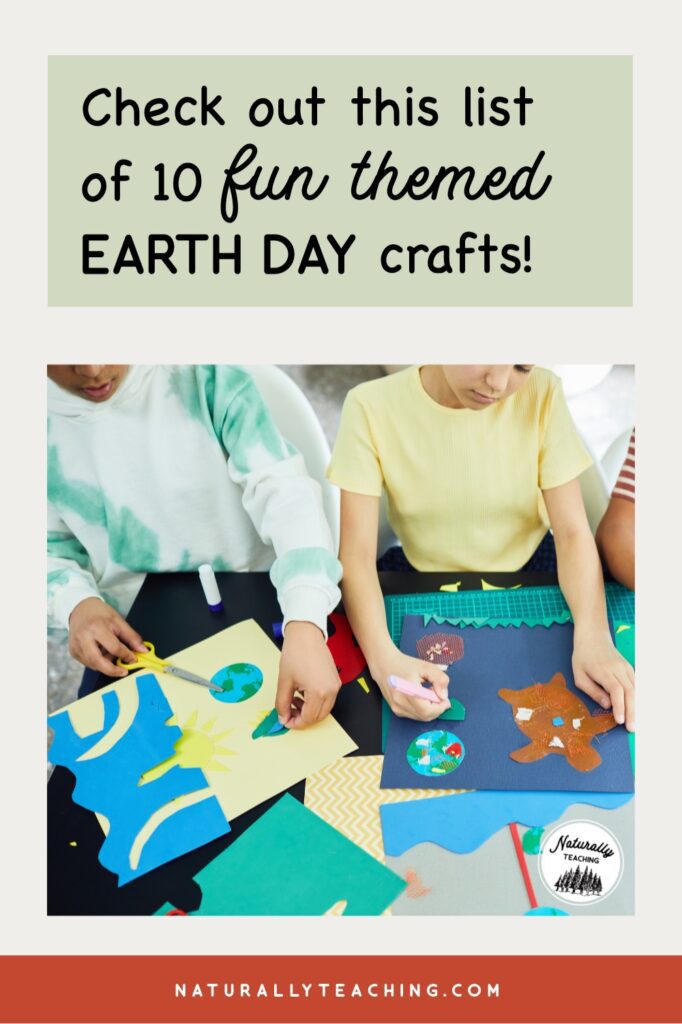
Check out this list of 10 fantastic Earth Day crafts for any Earth Day celebration!
Hopefully these Earth Day activities elementary students will love gave you some awesome ideas for your Earth Day celebration. No matter what Earth Day activities you decide to use this year, remember that you’re doing great work by observing this day with your students. To create stewards of our Earth they must first be introduced to the wonder and beauty of it. After there is a respect and appreciation for nature, then the desire to protect it can be cultivated. Thank you for helping make our future brighter by teaching our future advocates!
Bibliography
Americorps. (2022, April 27). The History of Arbor Day. Retrieved from https://mucc.org/the-history-of-arbor-day/?gclid=Cj0KCQjwtsCgBhDEARIsAE7RYh2EXbKcq1oNLvNV9vO1jGk6aH3i76zVpCl_NT1RkanqI2inQCnPH1YaAjRNEALw_wcB.
Earth Day. (NA). The History of Earth Day. Retrieved from https://www.earthday.org/history/.
HelpGuide. (NA). Organic Foods: What You Need to Know. Retrieved from https://www.helpguide.org/articles/healthy-eating/organic-foods.htm.
Do you have any amazing experiences celebrating Earth Day in your classroom? Describe them in the comments section to inspire a fellow elementary teacher to take action!
Looking for more description about kids Earth Day books to help you plan an introduction for your Earth Day activities elementary students will love this year? Check this one out!
“18 Kids Earth Day Books to Inspire Elementary Students This Year”
Thank you so much for including my bark in this great round up!